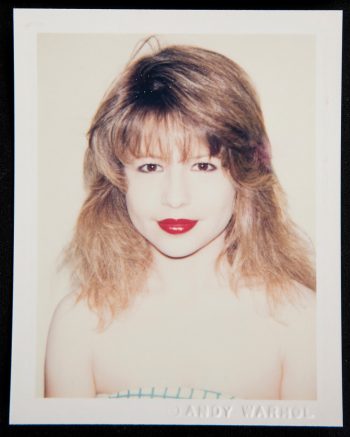by Tyler Spurgeon

Alex-Katz,-Ann-Lauterbach,1977,aquatint,UMFA#1976.008,Art-©-Alex-Katz_Licensed-by-VAGA,-New-York,-NY
The Utah Museum of Fine Art puts its best face forward with a collection of prints, photographs and sculpture. Most of the work in the show falls under the umbrella of Pop, and overtly or otherwise deals with portraiture.
The artists within Faces are well known, but the work shown is not necessarily what they are known for. Perhaps the most widely notable is Andy Warhol, whose Polaroid photographs – a recent gift of the Andy Warhol Foundation – are on view for the first time with this exhibit. Other big-hitters in the show include Alex Katz, Larry Rivers and Robert Arneson.
Alex Katz’ name is synonymous with large, billboard-sized oil paintings. In this exhibit we get a look at several of his etchings and aquatints instead. They lack most of the presence of his flagship works, but retain his stylistic charm and his sensitivity to the subject. The same flat colors that are used throughout his larger paintings translate remarkably well to the prints “Boy with Branch I” and “Anne Lauterbach.” The 12 etchings of “Untitled,” arranged in a grid on the wall and lacking his quintessential color palette, are a more somber approach to portraiture, not only in their lack of color but in their tight cropping. All of the foreheads, and in some cases even the chins, fall off the edge of the paper creating a too-tight cropping that is reminiscent of amateur photography. The portraits, small as they are, give the impression of expanding beyond the edges of the paper. The viewer is presented with an intimate perspective of what one imagines must be the close friends and family of the artist.

Andy Warhol,Pia Zadora, Polaroid (Polacolor ER),UMFA#-2008.15.30,Gift of The Andy Warhol Foundation for the Visual Arts,©The Andy Warhol Foundation for the Visual Arts,Inc.
For arguably the biggest name in the show, Andy Warhol’s works in Faces are not what the general public will expect to see. Warhol’s bombastic screen prints are a fixture of the collective consciousness, and visions of soup cans spring to mind at the mere mention of his name. Lesser known are his Polaroid portraits that served as both source material and works of art in their own right. Twenty of these Polaroid photos are on display, in five groups of four divided by the following criteria: two sets of women, two sets of men, and one set of people holding something – a baby, a dog, a lover. The groupings are probably for logistical reasons, but they intentionally or otherwise present each photo as part of a larger collection. While the groupings provide an interesting visual, they almost downplay the value of each Polaroid as an individual work – as if one photo on its own isn’t enough. They end up relying on each other for presence and validity. Like a collection of trading cards, you end up with your favorites, but the collection is worth more than any single card.
Robert Arneson’s work lends a sense of brevity to the show that is otherwise lacking. While his piece “Head Bath” mirrors the cropped foreheads of the Katz pieces, it takes it a step further, actually severing the top of the head above the eyebrows. While most viewers will not be familiar with Arneson, the piece is worth a closer look as a fairly representative example of his print career.

Andy Warhol, Polaroids, shown as part of the Faces exhibition at the UMFA,Gift of The Andy Warhol Foundation for the Visual Arts,©The Andy Warhol Foundation for the Visual Arts,Inc.
Larry Rivers has, if not the most interesting, the most complicated work of art in the exhibit. His screen print “Living at the Movies” features several people sitting in a movie theater. It is the only piece of work in the show that goes beyond the portrait aspect of a single subject. The print flips the vantage point of a theater, and instead turns the lens on the audience. In this representation, the audience is a manifestation of intimacy – perhaps more. Couples lovingly lean on each other and hold hands, as is common in a darkened theater. One close up of a woman holding a bucket of popcorn between her legs, shows her hand entering the bucket – a suggestive metaphor for other activities carried out in darkened theaters. The title implies that these activities are really what “living” at the movies is all about.

Robert Arneson, Head Bath, 1977, crayon on paper, purchased with funds from the Friends of the Art Museum, collection of the Utah Museum of Fine Arts, University of Utah, Art © Estate of Robert ArnesonLicensed by VAGA, New York, NY
The Chris Johanson sculpture “This is You” is the only piece that feels out of place. Made in 2002, it post-dates the other works in the show by a decade or more. While everything else in Faces is carefully framed, or protected behind glass, Johansen’s found-object-constructed sculpture feels common and cheap in comparison. What’s more, the face of the tiny man atop the piece’s curved arch is barely decipherable. Given the title, the piece is likely intended to be more of a commentary on the viewer and less a portrait of the man in the precarious position.
Faces: Selections from the Permanent Collection of Modern and Contemporary Art continues at the Utah Museum of Fine Arts through February 13, 2011.

UTAH’S ART MAGAZINE SINCE 2001, 15 Bytes is published by Artists of Utah, a 501 (c) 3 non-profit organization headquartered in Salt Lake City, Utah.
Categories: Exhibition Reviews | Visual Arts









